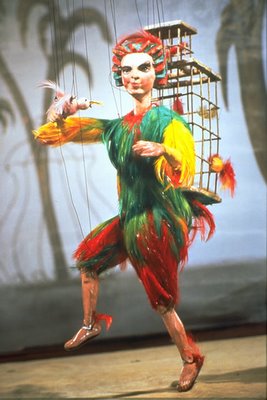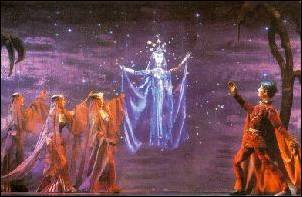Salzburg Marionnettes: Magic Flute
 Last night, Mini-Critic and I stayed up far past his regular bedtime to see the famous Salzburger Marionettentheater perform Mozart's magical Singspiel The Magic Flute. The troupe's two-night visit to the Kennedy Center's Terrace Theater was sponsored by Washington Performing Arts Society. It is hard to exaggerate just how exciting this was for both of us -- I was perhaps even more thrilled than Mini-Critic -- to see these famous marionnettes, a troupe founded in 1913 by sculptor Anton Aicher. (Anton's granddaughter Gretl now directs the troupe.)
Last night, Mini-Critic and I stayed up far past his regular bedtime to see the famous Salzburger Marionettentheater perform Mozart's magical Singspiel The Magic Flute. The troupe's two-night visit to the Kennedy Center's Terrace Theater was sponsored by Washington Performing Arts Society. It is hard to exaggerate just how exciting this was for both of us -- I was perhaps even more thrilled than Mini-Critic -- to see these famous marionnettes, a troupe founded in 1913 by sculptor Anton Aicher. (Anton's granddaughter Gretl now directs the troupe.)
The Terrace Theater stage was occupied by the smaller puppet stage, complete with its own curtain and the Salzburg heraldic arms hanging above it. The puppets themselves are incredibly detailed, with about a dozen or so wires each, which allows a rather lifelike, articulated style of movement. I don't know how the group achieves the lighting and set effects, which are both cartoonish and yet captivating in their realism. In many ways, the viewer is transported to another world by the marionnettes even more than in a normal opera. This is why marionnette opera is such a rich tradition, going back in France to the 17th century, when puppets performed mostly slapstick parodies of mainstream operas in the foires of Paris, that is, almost as far back as opera in France itself.
Magic Flute is the production that they stage most frequently, and its peculiar sense of the unreal seems to make it perfect for what they do. (Playing into some of my suggestions made elsewhere on Ionarts, the Salzburg marionnettes have also staged the operas of Wagner, although I cannot locate any pictures on their Web site. They also mount Offenbach's Tales of Hoffmann, which seems like a good match.) When you have to think about how to render the effects in an opera like Magic Flute, marionnettes start to sound like an ideal solution.
| Available from Amazon: W. A. Mozart, Trollflojten (Magic Flute), directed by Ingmar Bergman (1975) |
 The thing that most worried me about Mini-Critic's behavior during this performance, as we got ready to go to it, was how he was going to react to the dragon in that opening scene. It had begun to scare him in the movie, but the intermission shot of the actor in the dragon costume walking clumsily down a hallway seemed to calm his fears. As we walked up to the Kennedy Center, he kept repeating that the dragon was only a puppet. Happily, Mini-Critic was not terrified by the marionnette dragon, and he remained engaged and attentive throughout the longest performance he has experienced to date (mercifully abridged by the troupe to about 2 hours). He particularly liked Papageno and often asked when "the birdcatcher" was coming back on stage. In the Bergman film, he loved the balloon/cloud machine that the three boys or spirits ride in. He was somewhat disappointed by the marionnette boys, until in the second act they soared around in a fantastic helicopter-like device. When we got home, he told Mrs. Ionarts that he liked the three boys the best.
The thing that most worried me about Mini-Critic's behavior during this performance, as we got ready to go to it, was how he was going to react to the dragon in that opening scene. It had begun to scare him in the movie, but the intermission shot of the actor in the dragon costume walking clumsily down a hallway seemed to calm his fears. As we walked up to the Kennedy Center, he kept repeating that the dragon was only a puppet. Happily, Mini-Critic was not terrified by the marionnette dragon, and he remained engaged and attentive throughout the longest performance he has experienced to date (mercifully abridged by the troupe to about 2 hours). He particularly liked Papageno and often asked when "the birdcatcher" was coming back on stage. In the Bergman film, he loved the balloon/cloud machine that the three boys or spirits ride in. He was somewhat disappointed by the marionnette boys, until in the second act they soared around in a fantastic helicopter-like device. When we got home, he told Mrs. Ionarts that he liked the three boys the best.However, Mini-Critic laughed the loudest when Tamino's flute playing attracted the crowd of animals, one of the surprisingly few moments when the Salzburgers really went for big laughs. There was a splendidly tall giraffe, a lumbering elephant, a loopy-necked flamingo, and a nervy pelican that scratched the back of an appreciative lion. It was a stitch. The little white bird that fluttered around Papageno in his first scene was also a marvel to watch, so delicate and avian. Everything about the production was well considered and beautifully executed. One minor glitch, when Tamino's hand accidentally became snagged on Pamina's gown in the second act, was quickly rectified off stage. The choice of recording was good if not perfect: the 1950s Deutsche Grammophon version conducted by Ferenc Fricsay (rereleased on CD last year). Ernst Häfliger's Tamino was pure and sweet in tone, and Dietrich Fischer-Dieskau made a pleasing Papageno, especially, not to mention Maria Stader's Pamina.
Tickets are still available for the final performance of the Salzburg Marionnettes, Mozart's classic Italian opera Don Giovanni, this evening, November 9, at 7:30 pm. A flyer in our program last night announced a special 50% off rate ($30) for tickets to tonight's performance. Inquire at the Kennedy Center box office.
UPDATE:
See also the review by Daniel Ginsberg (Washington Post, November 10).





















































4 comments:
Wow, what a well-behaved little boy! He must have fabulous parents!
hello E.V., i see you had time to read ionarts, after all! :)
Jens, I can confirm your suspicion about this anonymous commenter. Beware, other anonymouses, Jens may eventually reveal your identity!
what would the perfect recording have been? boehm on decca with boehme as sarastro?
Post a Comment